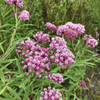
Asclepias incarnata - SWAMP MILKWEED
Swamp Milkweed is a true pollinator magnet; the pink to pink-purple flowers offer nectar to many types of insects. Hummingbirds are occasional visitors too. It's an important plant for monarch larvae - monarch butterfly caterpillars have the highest survival and growth rates on this particular milkweed.
Once the flowering process is complete, large green seed pods (3-4" long) form and turn brown as they mature, until they split along one side and release small brown seeds with enchanting white tufts that allow them to be carried away on the wind.
Deer, clay and boggy soil tolerant perennial for sunny borders, pollinator and butterfly gardens, or streams, pond banks and rain gardens. Easy to grow and highly beneficial native plant that grows in upright clumps.
The entire plant is mildly toxic to humans, dogs, cats, and livestock. It was selected as the 2005 NC Wildflower of the Year by the North Carolina Botanical Garden.
Blooming Time: July - August
Size: 3’ - 4' tall and wide
USDA Zones: 3 to 9
Culture: full sun to half shade, grows fairly well in average moist soils although it naturally grows in boggy conditions
Moisture Needs: medium to moist
Origin: native to every US state (except WA, OR, CA, AZ, and MS) and the SE 1/4 of Canada (USDA distribution map)
Deer/Rabbit Resistant: yes / no
Attracts Butterflies or Pollinators: native bees, bumble bees, honey bees, flies, wasps and butterflies like monarchs (host plant for larvae), swallowtail butterflies, Greater Fritillaries or skippers
Attracts Hummingbirds: yes
Pot Size: 3.5" x 5" deep pot

Asclepias incarnata - SWAMP MILKWEED
Swamp Milkweed is a true pollinator magnet; the pink to pink-purple flowers offer nectar to many types of insects. Hummingbirds are occasional visitors too. It's an important plant for monarch larvae - monarch butterfly caterpillars have the highest survival and growth rates on this particular milkweed.
Once the flowering process is complete, large green seed pods (3-4" long) form and turn brown as they mature, until they split along one side and release small brown seeds with enchanting white tufts that allow them to be carried away on the wind.
Deer, clay and boggy soil tolerant perennial for sunny borders, pollinator and butterfly gardens, or streams, pond banks and rain gardens. Easy to grow and highly beneficial native plant that grows in upright clumps.
The entire plant is mildly toxic to humans, dogs, cats, and livestock. It was selected as the 2005 NC Wildflower of the Year by the North Carolina Botanical Garden.
Blooming Time: July - August
Size: 3’ - 4' tall and wide
USDA Zones: 3 to 9
Culture: full sun to half shade, grows fairly well in average moist soils although it naturally grows in boggy conditions
Moisture Needs: medium to moist
Origin: native to every US state (except WA, OR, CA, AZ, and MS) and the SE 1/4 of Canada (USDA distribution map)
Deer/Rabbit Resistant: yes / no
Attracts Butterflies or Pollinators: native bees, bumble bees, honey bees, flies, wasps and butterflies like monarchs (host plant for larvae), swallowtail butterflies, Greater Fritillaries or skippers
Attracts Hummingbirds: yes
Pot Size: 3.5" x 5" deep pot
Customer Reviews
-
excellent
first year was excellent Monarch host plant!!
-
good quality
Just received these plants the other day, got them in ground today as it was first day with less than 35 mph wind! Can't say as to their continued growth, but as always, the plant quality shipped is phenomenal!
-
Looking forward to hosting monarch butterflies
These are going into a memorial garden for my mother who had a lifelong love of monarchs. She lovingly watched over and cared for all the caterpillars and chrysalises and even celebrated when each one matured. I hope to offer monarchs a place to thrive with the beautiful pink asclepiases to help increase their numbers.












